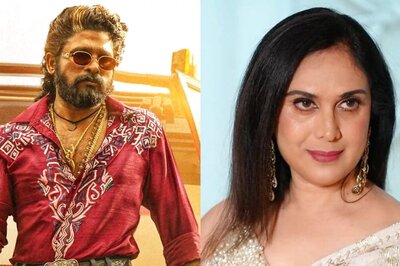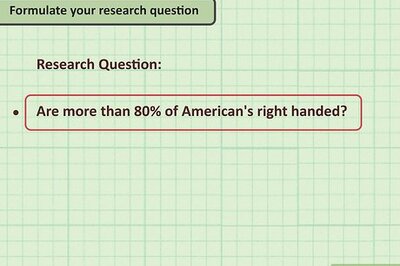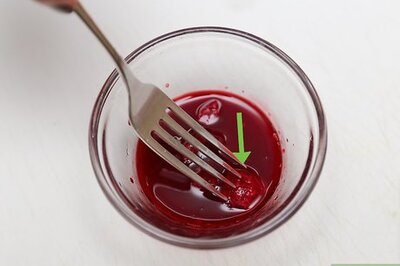
views
Identifying Your Beanie Baby
Use the tag or search online to find your Beanie Bay’s name. If you don’t have a protective cover on the tag, just look in the tag to find the Beanie Baby’s name. If the tag is protected, leave it be (it’s worth more if you don’t touch it) and search online. You might type something like “purple ostrich Beanie Baby” or “white bear with peace sign Beanie Baby” into the search engine of your choosing. Scan the photos until you find an image that matches your Beanie Baby to find its name. If you don’t have any tag protectors and you do end up having some valuable Beanie Babies, pick up some tag protectors. With some exceptions, most Beanie Baby’s had multiple printings across several editions, so it’s not enough to just know the name in the tag. You also need to know the edition of the Beanie Baby, but you can’t do that without the name.
Compare the hang tag to a tag edition chart to find what print run it’s from. There are 20 unique editions of Beanie Babies, and each of them have a different hang tag. Compare the hang tag to the chart to confirm what edition your Beanie Baby is. A hang tag refers to the red heart-shaped tag hanging from the Beanie Baby. Missing a tag? If the hang tag is missing, the only way to determine the edition of the Beanie Baby is to have it inspected and authenticated by a professional.
Confirm the hand and tush tag match. This is the best way to rule out counterfeits. Take a look at a tush tag chart and confirm the font, style, and composition are correct for the edition on the hand tag. If the tags don’t match, you have a fake Beanie Baby. You’d be surprised, but there are actually a lot of counterfeits floating around out there. During the height of the Beanie Baby frenzy, there was a lot of money to be made by buying cheaper versions of a Beanie Baby and then swapping the tags out for the pricier editions.
Pricing Your Beanie Baby
Run an eBay search for your Beanie Baby. eBay is, hands down, the most popular forum for buying and selling Beanie Babies these days. Punch your Beanie Bay’s name and edition into the search engine to pull up the results. So, say you’ve got a 4th edition Magic the White Dragon. Search “4th edition Magic the White Dragon” and then “4th gen Magic the White Dragon” to pull results.
Filter the results to find the “sold” listings. Anyone can put an eBay listing out for a $5 Beanie Baby and price it at $100 hoping someone buys it, but that doesn’t give you a realistic sense for the actual market value. Look at the left side of the page and scroll down until you see the “show only” menu option. Click “sold items” and unclick every other option. Scroll those results. If your item has no recently sold listings, look at the unsold listings to see what isn’t selling. You likely want to shoot a little lower than what’s currently out there.
Get an average price for your Beanie Babie based on recent sales. If you see there are 3 recently sold copies of your Beanie Baby that went for $8, $9, and $11.50. That’s an average price of $9.50. Use the average price you find to establish the baseline value of your Beanie Baby. If you’re a little disappointed by the pricing, consider holding on to the Beanie Baby for the future! Prices have been dropping for years, but they’ll eventually turn the other way if supply eventually slims down and interest in the product comes back.
Increase or decrease the price based on the quality of your Beanie Baby. Once you know what a reasonable average price for your Beanie Baby is, adjust your list price based on the quality of your Beanie Baby. Ask yourself the following questions: Is there any damage? If your Beanie Baby has any tears, rips, or stains, it’s not going to fetch top price. The reverse is also true if it’s damage-free, it’s worth a premium. Is the Beanie Baby in pristine condition? Are there any bent tags? Does the Beanie Baby have any frayed threads? If there’s nothing wrong with your Beanie Baby it’s worth top-shelf prices. Does the Beanie Baby have any key value adds? We break these down in detail in the next section, but if your Beanie Baby is uniquely rare, has misprints, or is certified, it’s worth listing at a higher price.
Key Value Adds
The Beanie Baby’s hang and tush tags are present. The tags are actually essential when it comes to assessing the value of your Beanie Baby. Without both the hang tag (the heart) and the tush tag (the white tag on the back), your Beanie Baby’s value likely drops by 80-90%. Is your tag misprinted? Misprints and errors are actually worth more a lot of the time. The uniqueness of the item increases its rarity.
You have a certificate of authenticity. There are two highly-regarded Beanie Baby authenticators: True Blue Beans and Peggy Gallagher Enterprises. You send them your Beanie Baby and they’ll return them in a sealed case with a certificate proving the provenance of the Beanie Baby. Get quotes before you send your Beanie Baby in. If the cost of authentication is higher than the value of your Beanie Baby, skip it.
It’s a first-generation Beanie Baby. The first generation of Beanie Babies, which were released in 1993, represent the origin of the entire collectible class. As a result, the first edition versions of popular Beanie Babies fetch a premium over their later versions.
The Beanie Baby was retired after a short run. Beanie Babies were often “retired” after short printings, so the short print run Beanie Babies tend to fetch a premium. If your Beanie Baby was only printed for one edition or it was released for a special occasion, it’s probably going to pay a pretty penny. Most of the “special event” and “celebrity” Beanie Babies (like the Girl Power Bear, which came out for Ginger Spice from the Spice Girls to celebrate women, or the Princess Diana Beanie Baby) had extremely limited print runs.
The Beanie Baby is a unique color or tie-dyed. Some Beanie Babies were given fresh or unique colors for certain print runs (for example, Patti the Platypus was purple for its standard editions, but there were some magenta versions that run a premium). The tie-dyed bears often run a pretty penny compared to their non tie-dyed peers as well, since the tie-dye pattern on each bear is 100% unique.
Selling Your Beanie Baby
Put it in a protective acrylic case if it isn’t in one. If you’re going to try selling a Beanie Baby for more than $20, set it in a protective case to keep it from getting dusty or dirty. If you’re selling a cheaper Beanie Baby (say $3-15), the case isn’t worth it. Warning Do not attempt to clean the Beanie Baby before selling it. Any cleaning chemicals or brushes can damage the Beanie Baby, and it’s probably worth more money dirty than clean and damaged.
Sell your Beanie Baby on eBay for the best prices. EBay is easily the best venue for Beanie Baby sales. Take several photos of the Beanie Baby you plan to sell and create an eBay profile. Then, upload the photos and post your Beanie Baby for sale. Wait for someone to reach out and purchase your Beanie Baby! Include the name of the Beanie Baby and the edition in the title of your post. If you aren’t getting any traction on eBay, try listing the Beanie Baby on Facebook Marketplace, Craigslist, and other online venues.
Take your Beanie Baby to a pawn shop to move it fast. If you don’t want to sit around waiting for an online buyer, take the Beanie Baby to a pawn shop. Many pawn shops sell inventory on eBay, and they’ll happily negotiate a sale with you. You can try offering the Beanie Baby to a consignment shop, where they sell goods for you and take a percentage of the profit. You’ll need to wait for the item to sell, though.
The Most Valuable Beanie Babies
Princess The purple Princess Diana Bear was released to help fund money for a memorial fund in honor of Princess Diana. Today, mint-condition Princess bears can fetch as much as $25,000.
Wise Wise the owl was released in 1998 around graduation time before being quickly retired a few months later. Wise isn’t especially expensive most of the time, but some of these owls were printed with the incorrect dates. One even fetched around $120,000!
Britannia Britannia the bear has a Union Jack printed on its chest. That, combined with its short print run, has created quite the demand among British collectors. These bears can fetch up to $5,000 on a regular basis, although especially pristine copies can cost up to $25,000.
The original 9 The original 9 refer to the first 9 Beanie Babies ever created. They vary in value, and most of them have had multiple print runs before retirement so the first editions are really the only high-priced versions, but they can fetch $20-30 on the low end and $35,000 on the high end. The original 9 include: Cubbie the bear Pinchers the lobster Patti the platypus Chocolate the moose Flash the dolphin Splash the orca Legs the frog Spot the dog Squealer the pig
















Comments
0 comment